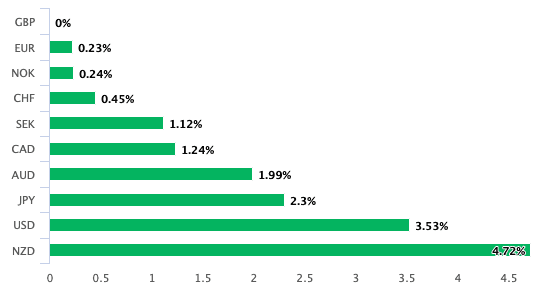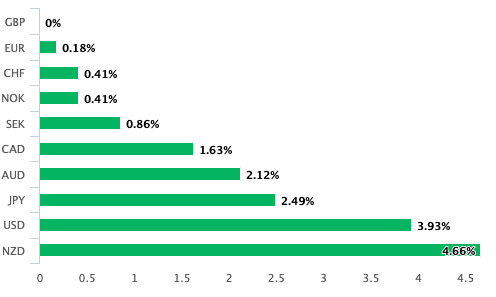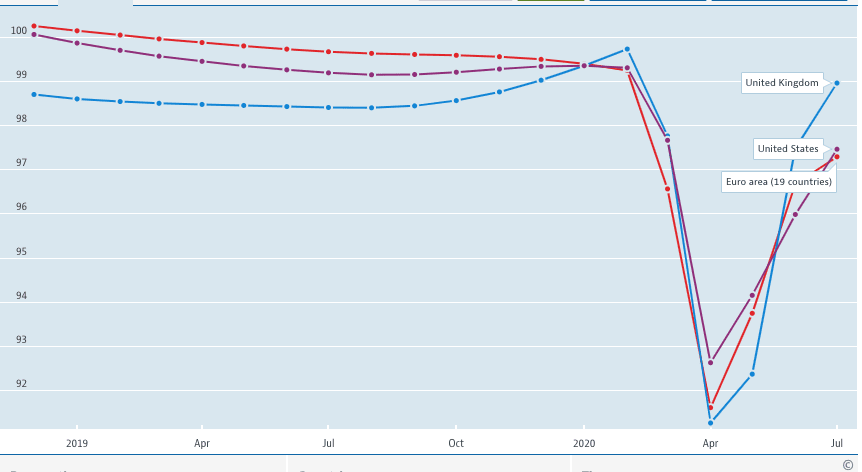Pound Sterling Best Performer of Past Month, and it's Not Just a Story of Dollar and Euro Weakness

Image © Adobe Images
- GBP/EUR spot: 1.1098 | GBP/USD spot: 1.3257
- GBP/EUR bank rates: 1.0880 | GBP/USD bank rates: 1.2980
- GBP/EUR specialist rates: 1.0990 | GBP/USD specialist rates: 1.3140
Learn more about market beating exchange rates, here
The British Pound is the best performing major currency of the past day and now the past month courtesy of a rout of the U.S. Dollar, but also because of a potential fundamental re-evaluation of the UK currency by the global investor community.
The standout move of the past 24 hours was the Pound going nearly a percent higher against the U.S. Dollar with the Pound-to-Dollar exchange rate going above 1.32 for the first time since January.
"This should not be mistaken for a vote of confidence by markets in the UK macro outlook. U.S. Dollar weakness, driven by the uniquely bad coronavirus situation in the U.S. and a changing outlook for Fed policy, has been behind most of the rally," says Ranko Berich, Head of Market Analysis at Monex Europe.
"Cable is doing its best to make GBP appear to be a well-supported currency," says Jane Foley, Senior FX Strategist at Rabobank. "The bullish run in cable, however, is almost completely a function of USD weakness."
Yet, when the Pound outperforms all its G10 peers over a multi-week timeframe, including the Euro which is the new darling of the FX market, idiosyncratic drivers specific to Sterling must be considered, i.e. there must be some genuine buying interest in Sterling as opposed to this simply being a story of Dollar weakness.
The below shows Sterling's outperformance against its major peers on Tuesday:

But the outperformance does not just rest on the short-term daily timeframe, it also shows over the past four weeks:

The Pound is by no means about to take off like a rocket - the Pound-to-Euro exchange rate is only up 0.20% over the past month and Sterling is holding small gains against a host of other currencies - but there does appear to be some genuine support at play.
The Dollar sell-off remains an obvious explainer of the Pound's current hot streak and there will certainly be an element of the GBP/USD's performance being 'a rising tide lifts all boats'.
The Dollar's underperformance and the Pound's outperformance comes amidst a broadly constructive equity market backdrop that sees the S&P 500 and Nasdaq hitting fresh records this week. The Pound maintains a 'high beta' with this asset class and we therefore see an element of the global story at play.
However, there are other currencies that maintain a higher beta to global investor sentiment, such as the Australian Dollar and emerging market currencies. We would therefore expect to at least see GBP/AUD under pressure on days where the global risk picture is all out positive.
Another driver of Sterling's outperformance must also be linked to Brexit trade negotiation sentiment where we believe markets are increasingly odds-on in expectation for a deal to be reached in October, even if the two sides continue to play the same tired tune that much more needs to be done before a deal can be reached while accusing the other side of being unrealistic in its demands.
But what has been abundantly clear when reading between the lines - via various off the record media briefings - is that both sides want a deal. The EU's Chief Negotiator Michel Barnier says he believes a deal will be reached, while the new Irish Taoiseach Micheál Martin said last week that Boris Johnson had shown a "genuine desire" to finalise a trade deal, and that the did not want to compound the coronavirus crisis with a "no deal" economic shock.
The risk reward of betting against Sterling given what appears to be decent odds for some sort of deal to be agreed by October looks less and less appealing, indeed data from the CFTC has shown investors have over recent days slashed their 'short' positions betting on Sterling downside.
This slashing of short positions is in itself a provider of upside impetus and there will certainly be an element of technical 'short squeezing' underway.
Then there is the economy, where the dominant narrative in the media and some sections of the FX commentariat remains one of UK exceptionalism (exceptionally bad). Yes, GDP statistics out last week confirmed the UK to have undergone one of the deepest, if not the deepest, contractions of a developed economy in the first half of the year.
But the important point to note is lockdown is now over and a recovery is underway and there is a genuine risk that the scope of the rebound is under-estimated.
The Bank of England's Chief Economist Andy Haldane can certainly not be accused of being a pessimist when it comes to the UK's economic recovery as he has for some time now been arguing a strong rebound is underway.
"The foundations for an economic recovery – a rapid one – are already in place, hiding in plain sight. Economic activity in the UK is not falling like stone, in fact it has now been rising for more than three months, sooner than anyone expected. It has also recovered far faster than anyone expected," said Haldane in an article for the Daily Mail at the weekend.
Indeed, Haldane is perhaps one reason why the Bank of England delivered an unanimous vote to keep interest rates and quantitative easing unchanged at their much-watched August policy decision.
The Pound will likely find itself supported as long as market expectations are erring away from expecting further rate cuts or quantitative easing.
The August decision by the Bank of England looks to be justified if we consider the scale of the economic recovery. Pound Sterling Live has been bandying about the following graph from the OECD for a week now:
The above shows the Composite Leading Indicators for the UK, US and Eurozone: the OECD gathers timely economic data from the world's largest economies and compiles it into its Composite Leading Indicator which gives a view of major turning points in an economic cycle and allows us to see how economies are performing relative to each other weeks ahead of the official data.
As we can see, timely economic data gathered from market surveys shows the UK's economic recovery has gathered pace and is potentially outperforming its peers.
If foreign exchange markets are focussed on relative economic outperformance when considering exchange rate levels, then there is a good argument to be made the Sterling's recent outperformance might have something to do with the economy.
But what is clear there are a number of factors at play, and for Sterling to continue outperforming, the following must continue:
1) markets and broader investor risk sentiment must stay supported
2) the Dollar's downtrend must continue
3) the markets must remain convinced that the EU and UK are still chipping away at a deal, despite the official briefings
4) the economy's recovery must stay intact
5) the Bank of England's policy makers must continue to pour cold water on the prospect of introducing negative interest rates
Of course none of the above are assured and on the Brexit front expect nerves to rise ahead of an expected European Council summit in October where a final deal would most likely to be secured.
On the matter of the economy there remain concerns that the ending of the government's job support scheme in October will trigger a new wave of unemployment which will have knock on effects for consumer and business confidence which could in turn invite a shift in sentiment at the Bank of England.
But, the important point is that the above are no longer all-out negatives for the Pound as they were in the April-June period which was characterised by notable Sterling weakness, and there is further upside to be had if more in the market start adopting a similar view.







